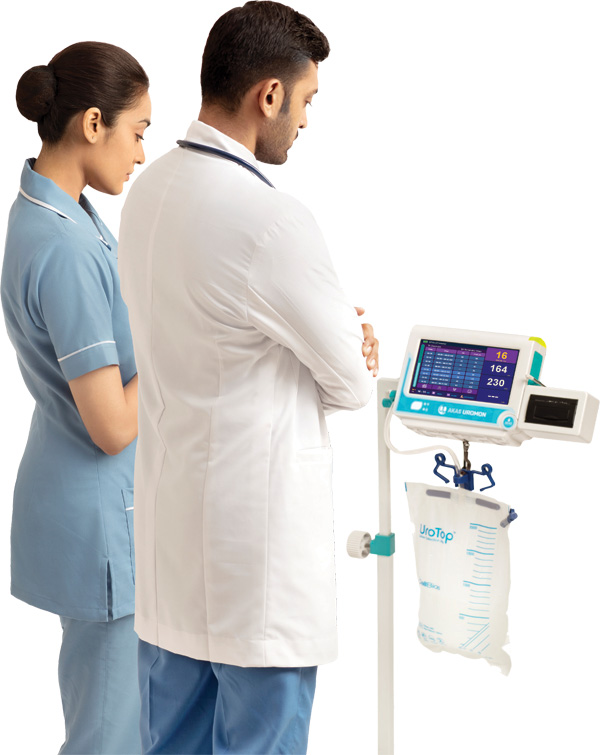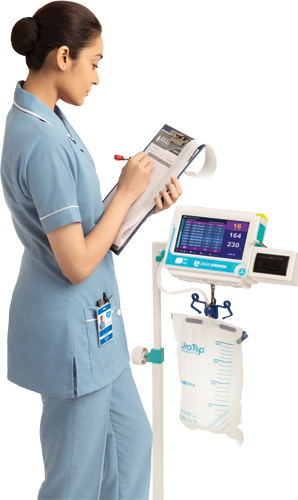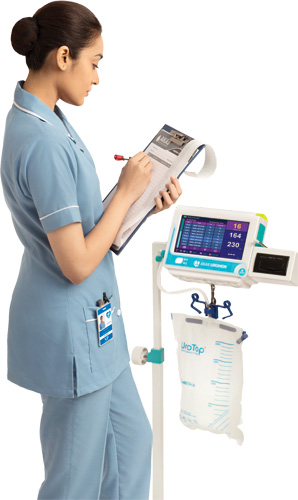
his Urine Output is the best indicator of the state of the patient’s kidneys. When the kidneys are producing an adequate amount of urine it means that they are well perfused and oxygenated. Otherwise, it indicates that the patient is suffering from some pathology. UO is used in multiple therapeutic protocols to assess how the patient reacts to treatment, such as the resuscitation of septic shock patients and the resuscitation and early management of burn patient Urine output (UO) is a vital sign for critically ill patients, but standards for monitoring and reporting vary widely between ICUs. Careful monitoring of UO could lead to earlier recognition of acute kidney injury (AKI) and better fluid management. The investigators sought to determine If the intensity of UO monitoring is associated with outcomes in patients with and those without AKI. The normal range of urine output is 800 to 2,000 milliliters per day if you have a normal fluid intake of about 2 liters per day.

Critical patients’ urine is collected in a graduated container which is often divided into several chambers with an overall capacity of approximately 500mL. This container is connected to a 1500–3000mL plastic bag. Every hour, the reading of the container of every patient must be manually recorded. This requires walking to the patient’s bed, taking the measure of UO production visually, writing it down on the nursing documentation sheet, opening the valve that releases urine from the graduated container to the plastic bag, waiting for the urine to drain, closing the valve, checking that the valve is properly sealed, and checking if the plastic bag needs to be emptied. This entire process can take up to two minutes. In a critical care unit with 10 patients, this means 20 minutes per hour, 8 hours a day. The automation of some steps of this process, or ideally of all the steps, could save a considerable amount of work. Furthermore, the frequency of measuring UO is determined not by physiological reasons, but by the convenience of its measurement over rather long periods of time such as one hour. A more continuous measurement of UO could permit the identification of changes in UO at earlier stages, with the associated potential for improving patient outcomes
Urine output (UO) is usually measured manually each hour in acutely ill patients. This task consumes a substantial amount of time. Furthermore, in the literature there is evidence that more frequent (minute-by-minute) UO measurement could impact clinical decision making and improve patient outcomes. However, it is not feasible to manually take minute-by-minute UO measurements. A device capable of automatically monitoring UO could save precious time of the healthcare staff and improve patient outcomes through a more precise and continuous monitoring of this parameter.
The urine output as it is has less meaning and if normalized with the body weight as mL/Kg/Hr is more meaningful. This calculation are little tedious for the nurses as it has to be done 24 times a day and for multiple patients in an ICU. Such everyday tasks are always best to leave it to computers/automation. The UO/kg/Hr over a few hours, that is the trend has some meaning and indicates certain conditions like Oliguria, Stages of AKI, Anuria, Polyuria etc. The machine can automatically Notify such conditions based on predefined algorithms. The intensivist can also modify the algorithms to notify in a different situation.
Acute kidney injury (AKI) is a condition characterized by a rapid reduction in the ability of the kidneys to filter waste from the blood, resulting in a failure to maintain fluid, electrolyte and acid-base (pH) homoeostasis. Previously called acute renal failure (ARF), AKI is now recognized as a spectrum of kidney injury. AKI develops rapidly over a few hours or days. It’s most common in those who are critically ill and already hospitalized.
When your kidneys lose their filtering ability, dangerous levels of wastes may accumulate, and your blood’s chemical makeup may get out of balance.
Acute kidney failure also called acute renal failure or acute kidney injury develops rapidly, usually in less than a few days. Acute kidney failure is most common in people who are already hospitalized, particularly in critically ill people who need intensive care unit (ICU).
Acute kidney failure can be fatal and requires intensive treatment. However, acute kidney failure may be reversible. If you’re otherwise in good health, you may recover normal or nearly normal kidney function
Oliguria is defined as a urine output that is less than 1 ml/kg/h in infants, less than 0.5 ml/kg/h in children, and less than 400 ml or 500 ml per 24h in adults - this equals 17 or 21 ml/hour. For example, in an adult weighing 70 kg it equals 0.24 or 0.3 ml/hour/kg. Alternatively, however, the value of 0.5 ml/kg/h is commonly used to define oliguria in adults as well.Oliguria is often observed in critically ill patients. While some studies have demonstrated that isolated oliguria without a concomitant increase in serum creatinine is associated with higher mortality rates, different underlying pathophysiological mechanisms suggest varied clinical importance of reduced UO, as some episodes of oliguria may be fully reversible. We aim to explore the clinical relevance of oliguria in critically ill patients and propose a clinical pathway for the diagnostic and therapeutic management of an oliguric, critically ill patient.

Anuria or anuresis occurs when the kidneys aren’t producing urine. A person may first experience oliguria, or low output of urine, and then progress to anuria.
Urination is important in removing both waste and excess fluids from your body. Your kidneys produce between 1 and 2 quarts of urine a day. When you don’t urinate, waste, fluids, and electrolytes can build up in your body. A decrease or total lack of urination can complicate any underlying health problems. It may even become life-threatening. Anuria is primarily linked to acute (sudden or short-term) or chronic (long-term) kidney disease. It may also be associated with other health conditions that cause kidney ailments. If you’re experiencing this symptom, you’ll need to see a doctor for proper diagnosis and treatment. Early treatment can also help prevent possible life-threatening complications.
Polyuria is a condition where the body urinates more than usual and passes excessive or abnormally large amounts of urine each time you urinate. Polyuria is defined as the frequent passage of large volumes of urine - more than 3 litres a day compared to the normal daily urine output in adults of about one to two litres. It is one of the main symptoms of diabetes (both type 1 and type 2 diabetes) and can lead to severe dehydration, which if left untreated can affect kidney function.
We have designed and built a device capable of automatically monitoring the UO of critical care patients. This device automates all tasks related to the monitoring of UO. Currently this parameter is measured and monitored manually by nursing staff, which requires at least one supervisory visit to the patient’s bedside every hour. We estimate that this device could save up to 7 hours of nursing staff work per day per 10 patients. Furthermore, with this device more frequent urine production measures can be taken. In the literature there is evidence that indicates that more frequent UO measurement can impact clinical decision making and improve patient outcomes and hence the interest of the device presented in this paper.
